Financial Audit Report: Analysis of GPSA Limited's Financials
VerifiedAdded on 2020/04/01
|13
|2748
|31
Report
AI Summary
This report presents an audit analysis of GPSA Limited, a company involved in manufacturing, retail, and property investment. The report, prepared by MYH partners, evaluates the company's financial statements, including accounts receivable, current investments, and property assets. It assesses audit risks and outlines steps to mitigate them, such as reviewing past financial statements and strategic audit planning. The analysis includes a review of key financial ratios, identifying business risks like declining return on equity and increasing costs. The report also examines the company's internal controls for sales and trade receivables, highlighting strengths and weaknesses. The audit focuses on providing an assessment of the company's financial health and the effectiveness of its internal controls, crucial for ensuring profitability and managing risks. The report also covers areas of concern such as the increase in days in accounts receivable and the decline in interest earned from investments. The report also includes an analysis of the weaknesses in internal controls for sales and trade receivables.
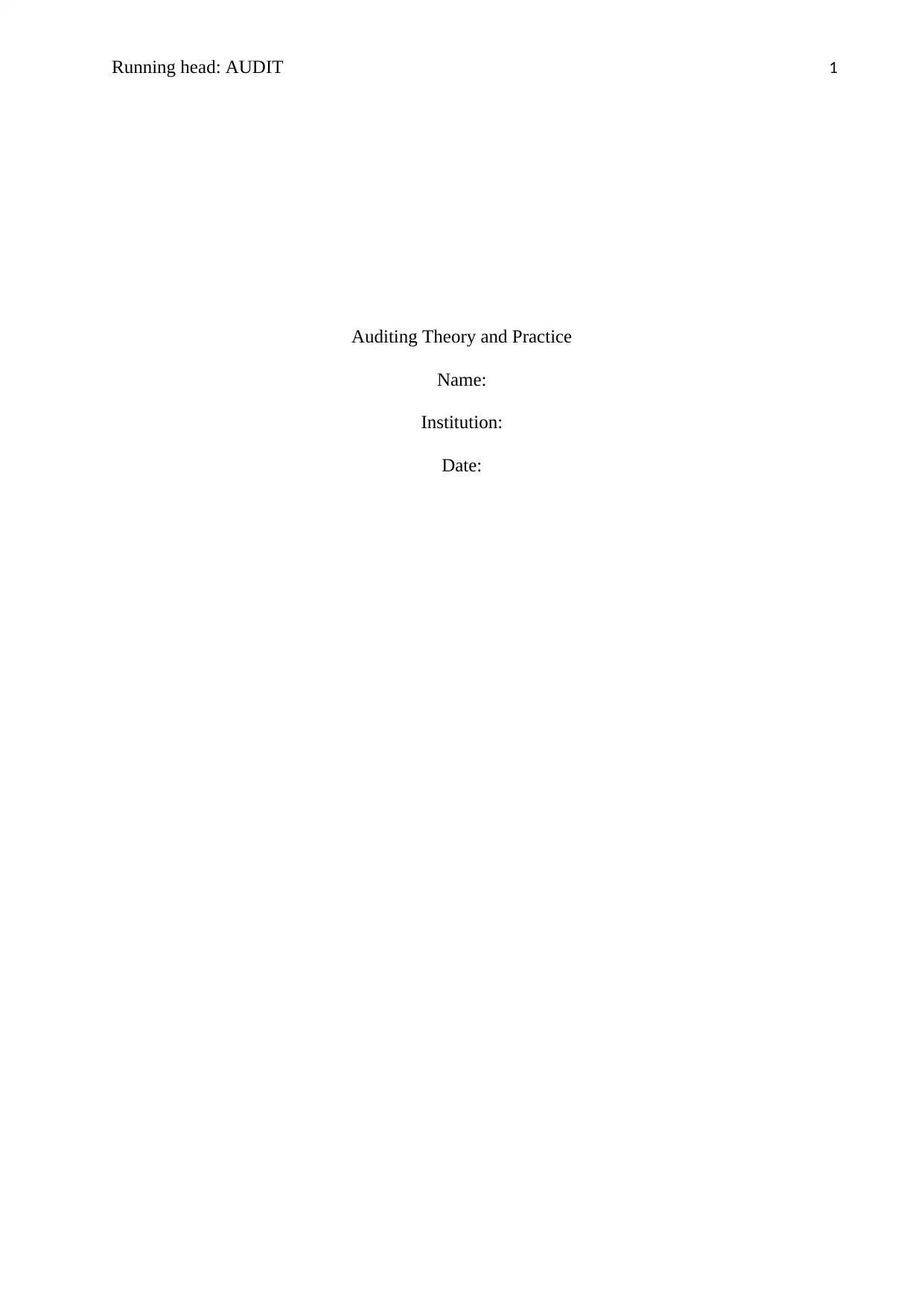
Running head: AUDIT 1
Auditing Theory and Practice
Name:
Institution:
Date:
Auditing Theory and Practice
Name:
Institution:
Date:
Paraphrase This Document
Need a fresh take? Get an instant paraphrase of this document with our AI Paraphraser
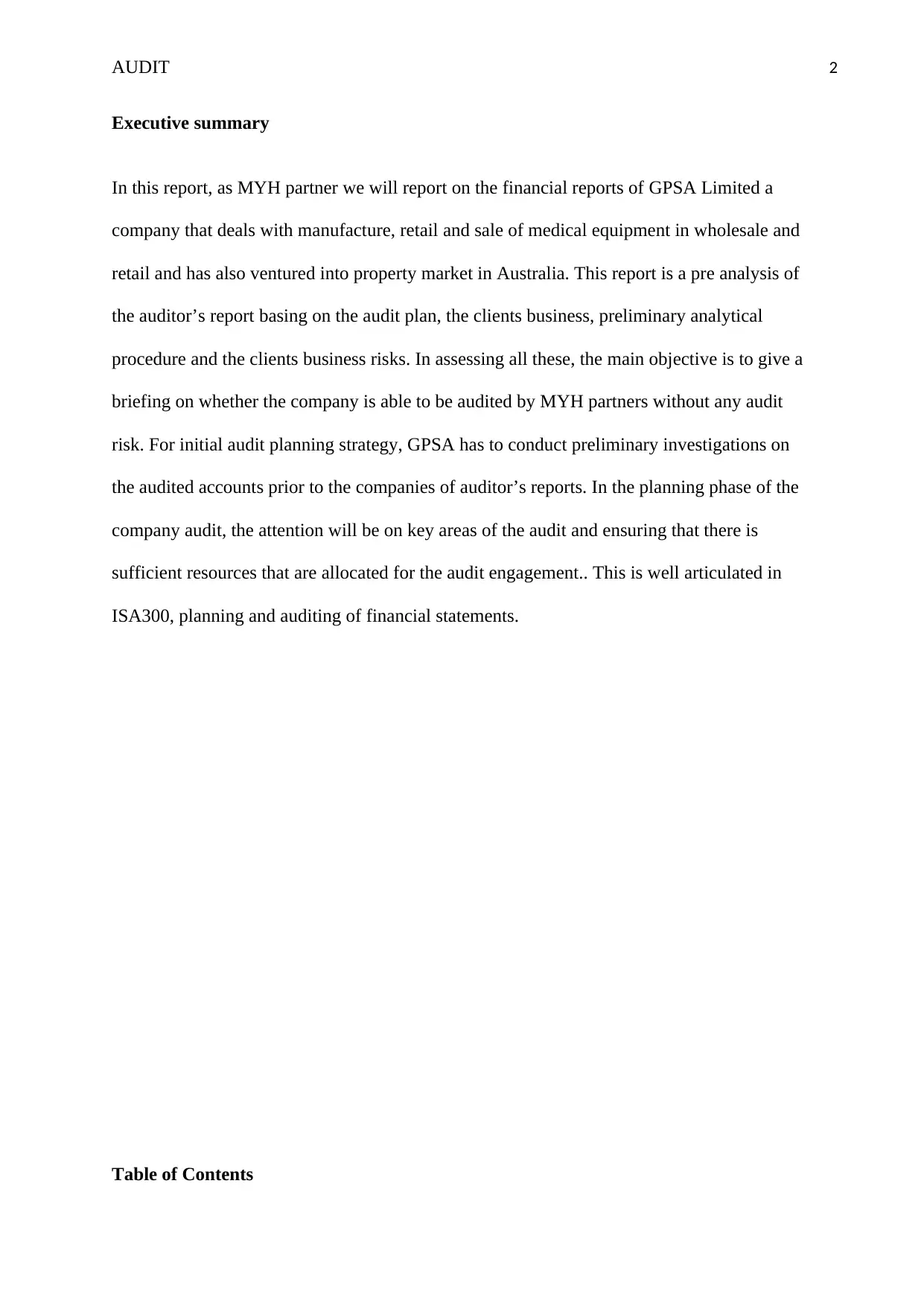
AUDIT 2
Executive summary
In this report, as MYH partner we will report on the financial reports of GPSA Limited a
company that deals with manufacture, retail and sale of medical equipment in wholesale and
retail and has also ventured into property market in Australia. This report is a pre analysis of
the auditor’s report basing on the audit plan, the clients business, preliminary analytical
procedure and the clients business risks. In assessing all these, the main objective is to give a
briefing on whether the company is able to be audited by MYH partners without any audit
risk. For initial audit planning strategy, GPSA has to conduct preliminary investigations on
the audited accounts prior to the companies of auditor’s reports. In the planning phase of the
company audit, the attention will be on key areas of the audit and ensuring that there is
sufficient resources that are allocated for the audit engagement.. This is well articulated in
ISA300, planning and auditing of financial statements.
Table of Contents
Executive summary
In this report, as MYH partner we will report on the financial reports of GPSA Limited a
company that deals with manufacture, retail and sale of medical equipment in wholesale and
retail and has also ventured into property market in Australia. This report is a pre analysis of
the auditor’s report basing on the audit plan, the clients business, preliminary analytical
procedure and the clients business risks. In assessing all these, the main objective is to give a
briefing on whether the company is able to be audited by MYH partners without any audit
risk. For initial audit planning strategy, GPSA has to conduct preliminary investigations on
the audited accounts prior to the companies of auditor’s reports. In the planning phase of the
company audit, the attention will be on key areas of the audit and ensuring that there is
sufficient resources that are allocated for the audit engagement.. This is well articulated in
ISA300, planning and auditing of financial statements.
Table of Contents
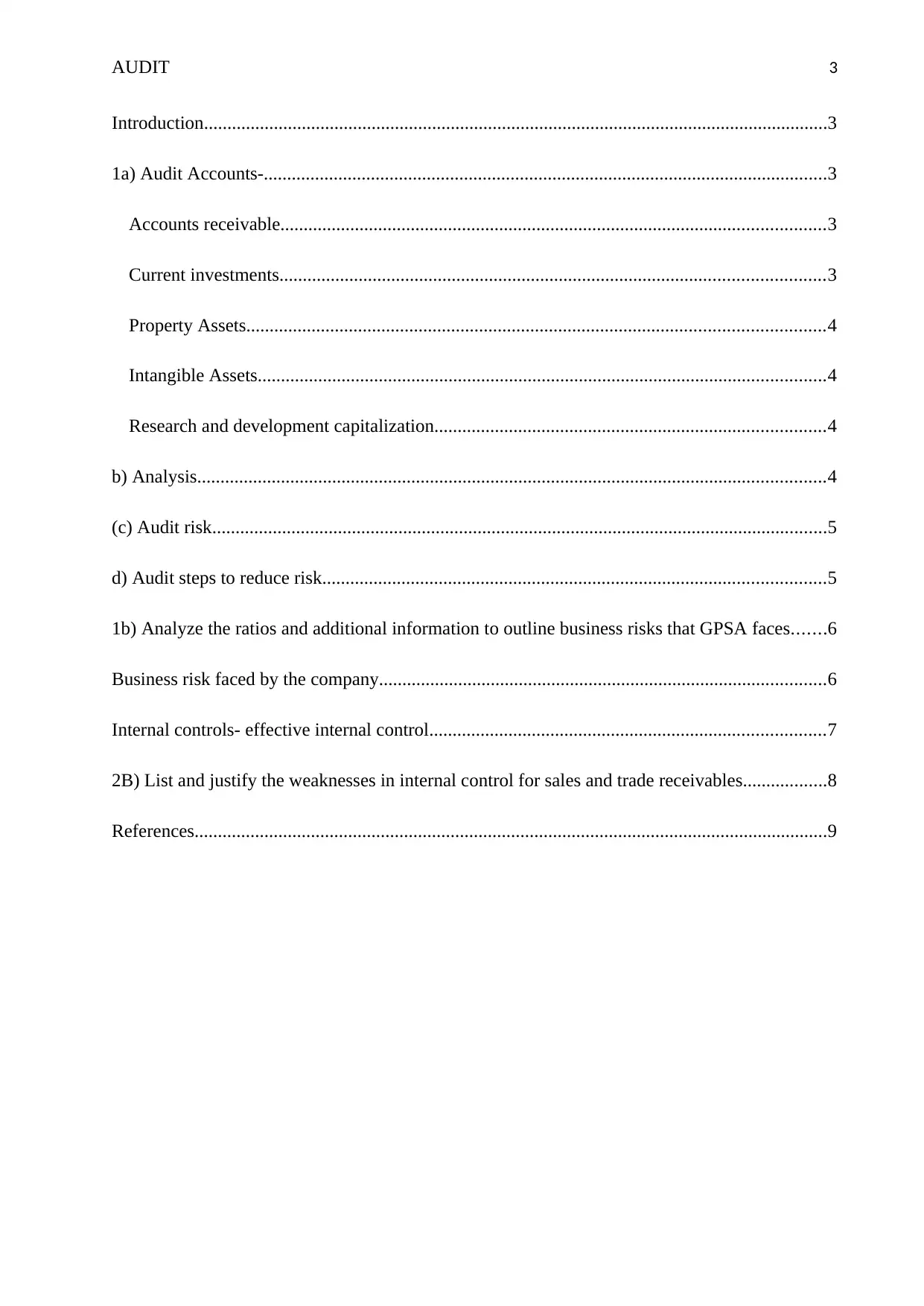
AUDIT 3
Introduction......................................................................................................................................3
1a) Audit Accounts-.........................................................................................................................3
Accounts receivable.....................................................................................................................3
Current investments.....................................................................................................................3
Property Assets............................................................................................................................4
Intangible Assets..........................................................................................................................4
Research and development capitalization....................................................................................4
b) Analysis.......................................................................................................................................4
(c) Audit risk....................................................................................................................................5
d) Audit steps to reduce risk............................................................................................................5
1b) Analyze the ratios and additional information to outline business risks that GPSA faces.......6
Business risk faced by the company................................................................................................6
Internal controls- effective internal control.....................................................................................7
2B) List and justify the weaknesses in internal control for sales and trade receivables..................8
References........................................................................................................................................9
Introduction......................................................................................................................................3
1a) Audit Accounts-.........................................................................................................................3
Accounts receivable.....................................................................................................................3
Current investments.....................................................................................................................3
Property Assets............................................................................................................................4
Intangible Assets..........................................................................................................................4
Research and development capitalization....................................................................................4
b) Analysis.......................................................................................................................................4
(c) Audit risk....................................................................................................................................5
d) Audit steps to reduce risk............................................................................................................5
1b) Analyze the ratios and additional information to outline business risks that GPSA faces.......6
Business risk faced by the company................................................................................................6
Internal controls- effective internal control.....................................................................................7
2B) List and justify the weaknesses in internal control for sales and trade receivables..................8
References........................................................................................................................................9
⊘ This is a preview!⊘
Do you want full access?
Subscribe today to unlock all pages.

Trusted by 1+ million students worldwide
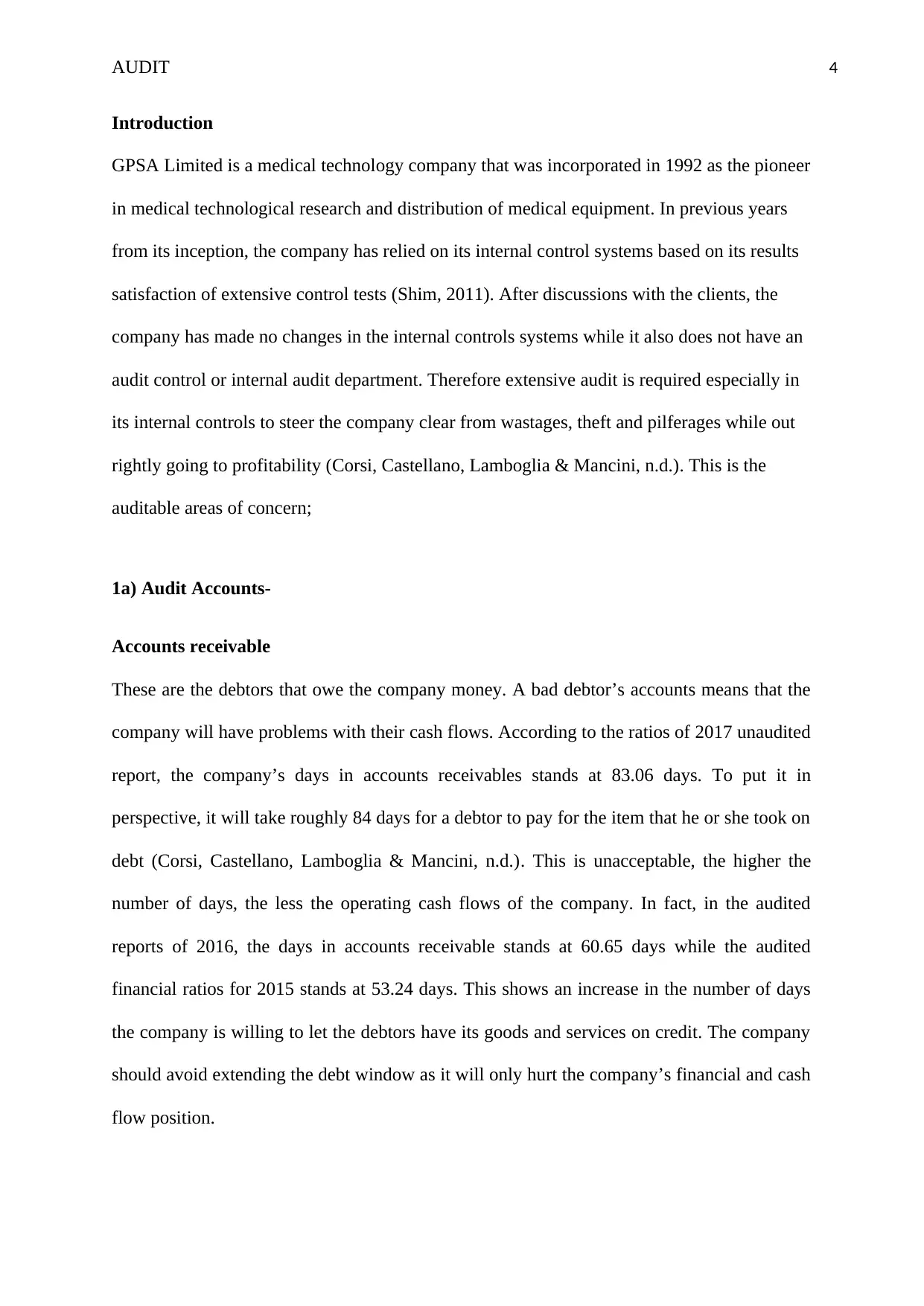
AUDIT 4
Introduction
GPSA Limited is a medical technology company that was incorporated in 1992 as the pioneer
in medical technological research and distribution of medical equipment. In previous years
from its inception, the company has relied on its internal control systems based on its results
satisfaction of extensive control tests (Shim, 2011). After discussions with the clients, the
company has made no changes in the internal controls systems while it also does not have an
audit control or internal audit department. Therefore extensive audit is required especially in
its internal controls to steer the company clear from wastages, theft and pilferages while out
rightly going to profitability (Corsi, Castellano, Lamboglia & Mancini, n.d.). This is the
auditable areas of concern;
1a) Audit Accounts-
Accounts receivable
These are the debtors that owe the company money. A bad debtor’s accounts means that the
company will have problems with their cash flows. According to the ratios of 2017 unaudited
report, the company’s days in accounts receivables stands at 83.06 days. To put it in
perspective, it will take roughly 84 days for a debtor to pay for the item that he or she took on
debt (Corsi, Castellano, Lamboglia & Mancini, n.d.). This is unacceptable, the higher the
number of days, the less the operating cash flows of the company. In fact, in the audited
reports of 2016, the days in accounts receivable stands at 60.65 days while the audited
financial ratios for 2015 stands at 53.24 days. This shows an increase in the number of days
the company is willing to let the debtors have its goods and services on credit. The company
should avoid extending the debt window as it will only hurt the company’s financial and cash
flow position.
Introduction
GPSA Limited is a medical technology company that was incorporated in 1992 as the pioneer
in medical technological research and distribution of medical equipment. In previous years
from its inception, the company has relied on its internal control systems based on its results
satisfaction of extensive control tests (Shim, 2011). After discussions with the clients, the
company has made no changes in the internal controls systems while it also does not have an
audit control or internal audit department. Therefore extensive audit is required especially in
its internal controls to steer the company clear from wastages, theft and pilferages while out
rightly going to profitability (Corsi, Castellano, Lamboglia & Mancini, n.d.). This is the
auditable areas of concern;
1a) Audit Accounts-
Accounts receivable
These are the debtors that owe the company money. A bad debtor’s accounts means that the
company will have problems with their cash flows. According to the ratios of 2017 unaudited
report, the company’s days in accounts receivables stands at 83.06 days. To put it in
perspective, it will take roughly 84 days for a debtor to pay for the item that he or she took on
debt (Corsi, Castellano, Lamboglia & Mancini, n.d.). This is unacceptable, the higher the
number of days, the less the operating cash flows of the company. In fact, in the audited
reports of 2016, the days in accounts receivable stands at 60.65 days while the audited
financial ratios for 2015 stands at 53.24 days. This shows an increase in the number of days
the company is willing to let the debtors have its goods and services on credit. The company
should avoid extending the debt window as it will only hurt the company’s financial and cash
flow position.
Paraphrase This Document
Need a fresh take? Get an instant paraphrase of this document with our AI Paraphraser
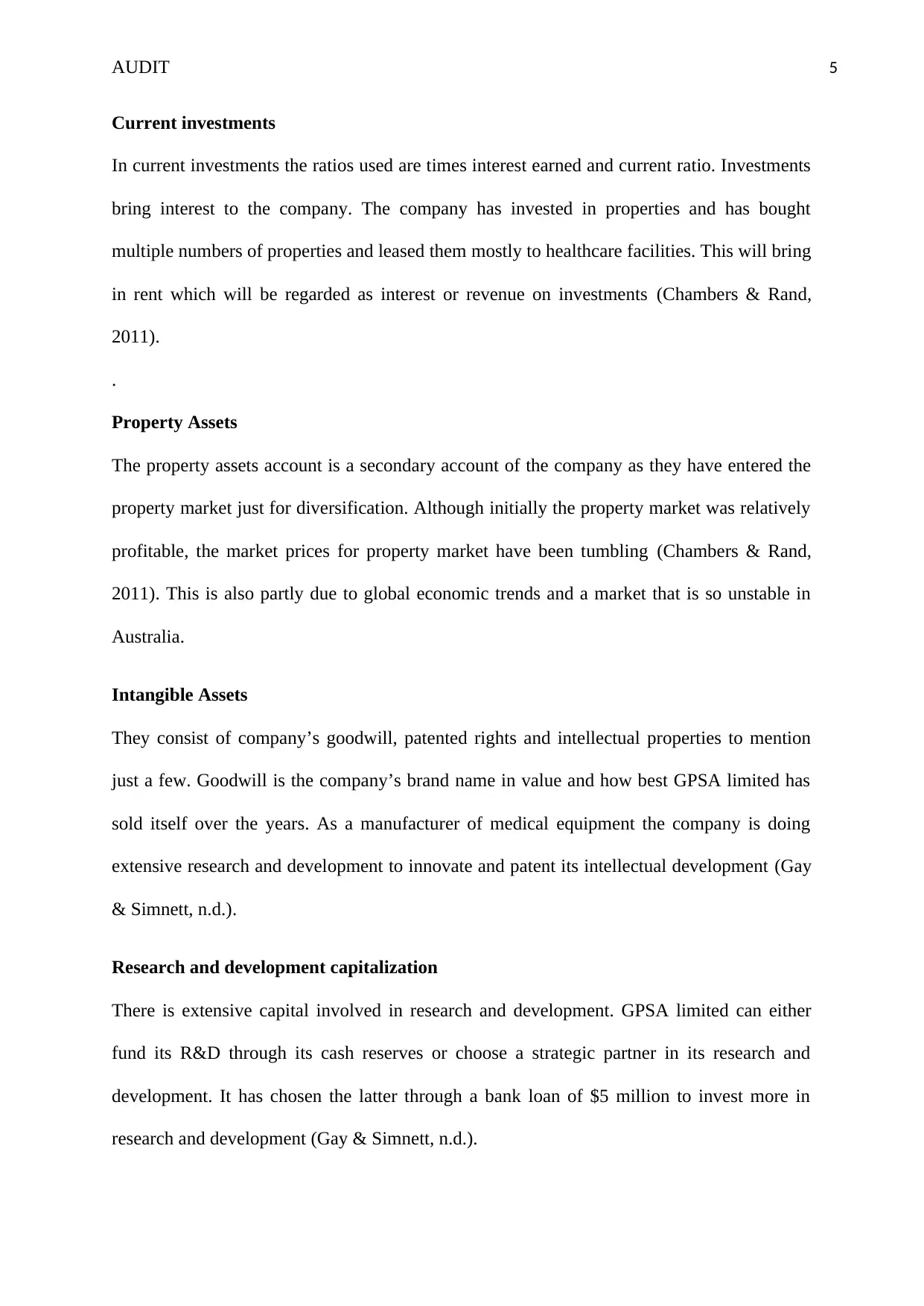
AUDIT 5
Current investments
In current investments the ratios used are times interest earned and current ratio. Investments
bring interest to the company. The company has invested in properties and has bought
multiple numbers of properties and leased them mostly to healthcare facilities. This will bring
in rent which will be regarded as interest or revenue on investments (Chambers & Rand,
2011).
.
Property Assets
The property assets account is a secondary account of the company as they have entered the
property market just for diversification. Although initially the property market was relatively
profitable, the market prices for property market have been tumbling (Chambers & Rand,
2011). This is also partly due to global economic trends and a market that is so unstable in
Australia.
Intangible Assets
They consist of company’s goodwill, patented rights and intellectual properties to mention
just a few. Goodwill is the company’s brand name in value and how best GPSA limited has
sold itself over the years. As a manufacturer of medical equipment the company is doing
extensive research and development to innovate and patent its intellectual development (Gay
& Simnett, n.d.).
Research and development capitalization
There is extensive capital involved in research and development. GPSA limited can either
fund its R&D through its cash reserves or choose a strategic partner in its research and
development. It has chosen the latter through a bank loan of $5 million to invest more in
research and development (Gay & Simnett, n.d.).
Current investments
In current investments the ratios used are times interest earned and current ratio. Investments
bring interest to the company. The company has invested in properties and has bought
multiple numbers of properties and leased them mostly to healthcare facilities. This will bring
in rent which will be regarded as interest or revenue on investments (Chambers & Rand,
2011).
.
Property Assets
The property assets account is a secondary account of the company as they have entered the
property market just for diversification. Although initially the property market was relatively
profitable, the market prices for property market have been tumbling (Chambers & Rand,
2011). This is also partly due to global economic trends and a market that is so unstable in
Australia.
Intangible Assets
They consist of company’s goodwill, patented rights and intellectual properties to mention
just a few. Goodwill is the company’s brand name in value and how best GPSA limited has
sold itself over the years. As a manufacturer of medical equipment the company is doing
extensive research and development to innovate and patent its intellectual development (Gay
& Simnett, n.d.).
Research and development capitalization
There is extensive capital involved in research and development. GPSA limited can either
fund its R&D through its cash reserves or choose a strategic partner in its research and
development. It has chosen the latter through a bank loan of $5 million to invest more in
research and development (Gay & Simnett, n.d.).
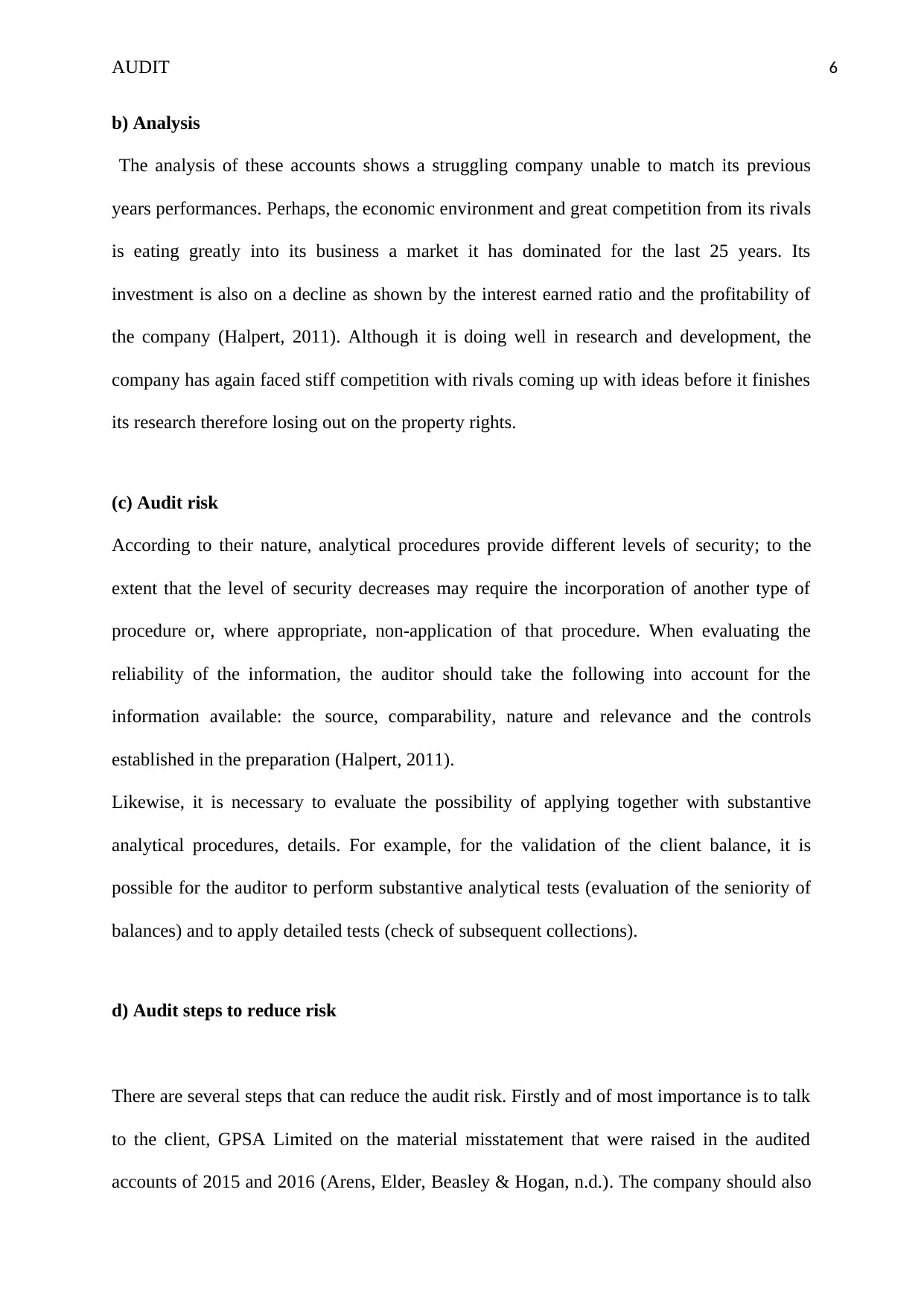
AUDIT 6
b) Analysis
The analysis of these accounts shows a struggling company unable to match its previous
years performances. Perhaps, the economic environment and great competition from its rivals
is eating greatly into its business a market it has dominated for the last 25 years. Its
investment is also on a decline as shown by the interest earned ratio and the profitability of
the company (Halpert, 2011). Although it is doing well in research and development, the
company has again faced stiff competition with rivals coming up with ideas before it finishes
its research therefore losing out on the property rights.
(c) Audit risk
According to their nature, analytical procedures provide different levels of security; to the
extent that the level of security decreases may require the incorporation of another type of
procedure or, where appropriate, non-application of that procedure. When evaluating the
reliability of the information, the auditor should take the following into account for the
information available: the source, comparability, nature and relevance and the controls
established in the preparation (Halpert, 2011).
Likewise, it is necessary to evaluate the possibility of applying together with substantive
analytical procedures, details. For example, for the validation of the client balance, it is
possible for the auditor to perform substantive analytical tests (evaluation of the seniority of
balances) and to apply detailed tests (check of subsequent collections).
d) Audit steps to reduce risk
There are several steps that can reduce the audit risk. Firstly and of most importance is to talk
to the client, GPSA Limited on the material misstatement that were raised in the audited
accounts of 2015 and 2016 (Arens, Elder, Beasley & Hogan, n.d.). The company should also
b) Analysis
The analysis of these accounts shows a struggling company unable to match its previous
years performances. Perhaps, the economic environment and great competition from its rivals
is eating greatly into its business a market it has dominated for the last 25 years. Its
investment is also on a decline as shown by the interest earned ratio and the profitability of
the company (Halpert, 2011). Although it is doing well in research and development, the
company has again faced stiff competition with rivals coming up with ideas before it finishes
its research therefore losing out on the property rights.
(c) Audit risk
According to their nature, analytical procedures provide different levels of security; to the
extent that the level of security decreases may require the incorporation of another type of
procedure or, where appropriate, non-application of that procedure. When evaluating the
reliability of the information, the auditor should take the following into account for the
information available: the source, comparability, nature and relevance and the controls
established in the preparation (Halpert, 2011).
Likewise, it is necessary to evaluate the possibility of applying together with substantive
analytical procedures, details. For example, for the validation of the client balance, it is
possible for the auditor to perform substantive analytical tests (evaluation of the seniority of
balances) and to apply detailed tests (check of subsequent collections).
d) Audit steps to reduce risk
There are several steps that can reduce the audit risk. Firstly and of most importance is to talk
to the client, GPSA Limited on the material misstatement that were raised in the audited
accounts of 2015 and 2016 (Arens, Elder, Beasley & Hogan, n.d.). The company should also
⊘ This is a preview!⊘
Do you want full access?
Subscribe today to unlock all pages.

Trusted by 1+ million students worldwide
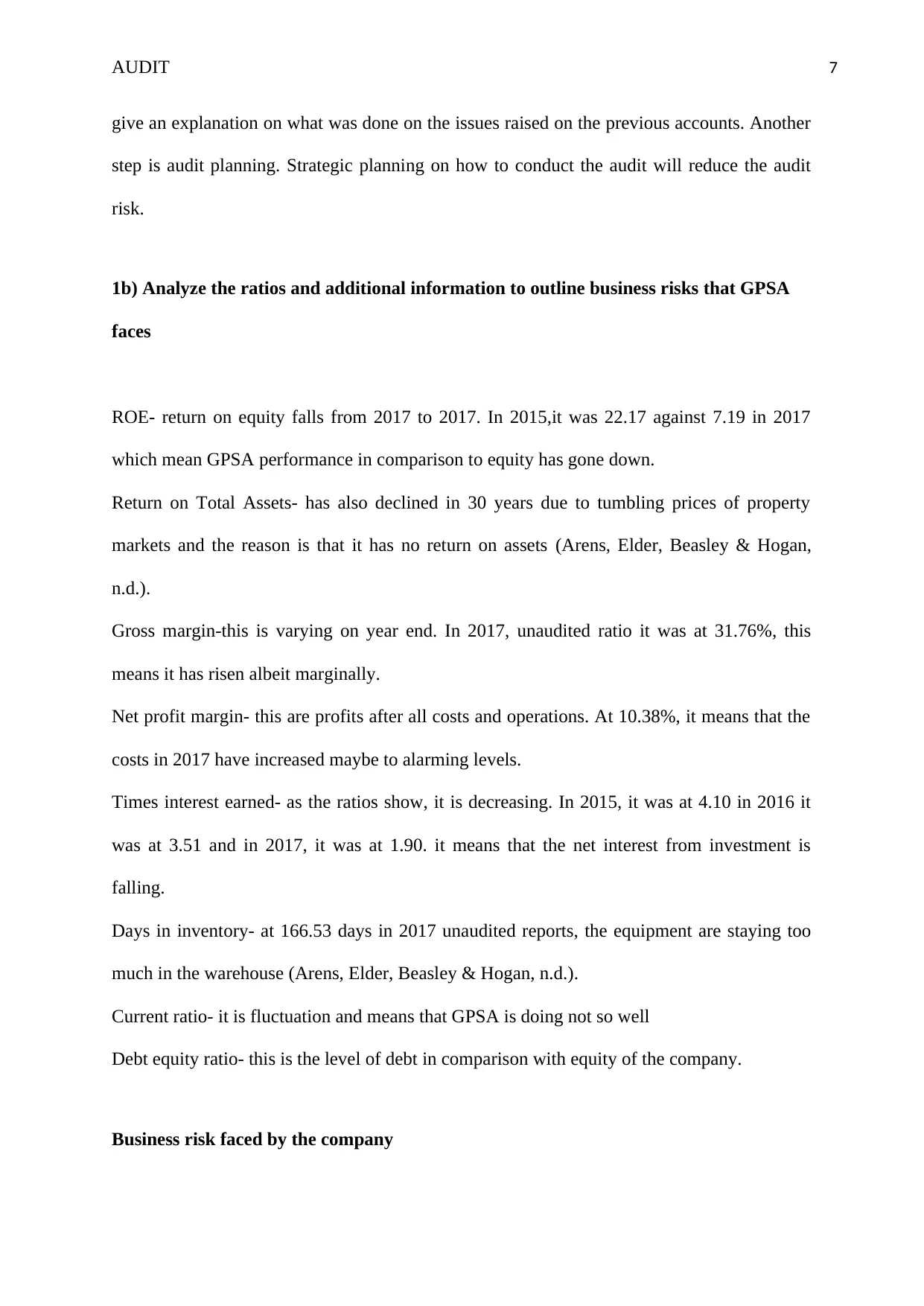
AUDIT 7
give an explanation on what was done on the issues raised on the previous accounts. Another
step is audit planning. Strategic planning on how to conduct the audit will reduce the audit
risk.
1b) Analyze the ratios and additional information to outline business risks that GPSA
faces
ROE- return on equity falls from 2017 to 2017. In 2015,it was 22.17 against 7.19 in 2017
which mean GPSA performance in comparison to equity has gone down.
Return on Total Assets- has also declined in 30 years due to tumbling prices of property
markets and the reason is that it has no return on assets (Arens, Elder, Beasley & Hogan,
n.d.).
Gross margin-this is varying on year end. In 2017, unaudited ratio it was at 31.76%, this
means it has risen albeit marginally.
Net profit margin- this are profits after all costs and operations. At 10.38%, it means that the
costs in 2017 have increased maybe to alarming levels.
Times interest earned- as the ratios show, it is decreasing. In 2015, it was at 4.10 in 2016 it
was at 3.51 and in 2017, it was at 1.90. it means that the net interest from investment is
falling.
Days in inventory- at 166.53 days in 2017 unaudited reports, the equipment are staying too
much in the warehouse (Arens, Elder, Beasley & Hogan, n.d.).
Current ratio- it is fluctuation and means that GPSA is doing not so well
Debt equity ratio- this is the level of debt in comparison with equity of the company.
Business risk faced by the company
give an explanation on what was done on the issues raised on the previous accounts. Another
step is audit planning. Strategic planning on how to conduct the audit will reduce the audit
risk.
1b) Analyze the ratios and additional information to outline business risks that GPSA
faces
ROE- return on equity falls from 2017 to 2017. In 2015,it was 22.17 against 7.19 in 2017
which mean GPSA performance in comparison to equity has gone down.
Return on Total Assets- has also declined in 30 years due to tumbling prices of property
markets and the reason is that it has no return on assets (Arens, Elder, Beasley & Hogan,
n.d.).
Gross margin-this is varying on year end. In 2017, unaudited ratio it was at 31.76%, this
means it has risen albeit marginally.
Net profit margin- this are profits after all costs and operations. At 10.38%, it means that the
costs in 2017 have increased maybe to alarming levels.
Times interest earned- as the ratios show, it is decreasing. In 2015, it was at 4.10 in 2016 it
was at 3.51 and in 2017, it was at 1.90. it means that the net interest from investment is
falling.
Days in inventory- at 166.53 days in 2017 unaudited reports, the equipment are staying too
much in the warehouse (Arens, Elder, Beasley & Hogan, n.d.).
Current ratio- it is fluctuation and means that GPSA is doing not so well
Debt equity ratio- this is the level of debt in comparison with equity of the company.
Business risk faced by the company
Paraphrase This Document
Need a fresh take? Get an instant paraphrase of this document with our AI Paraphraser
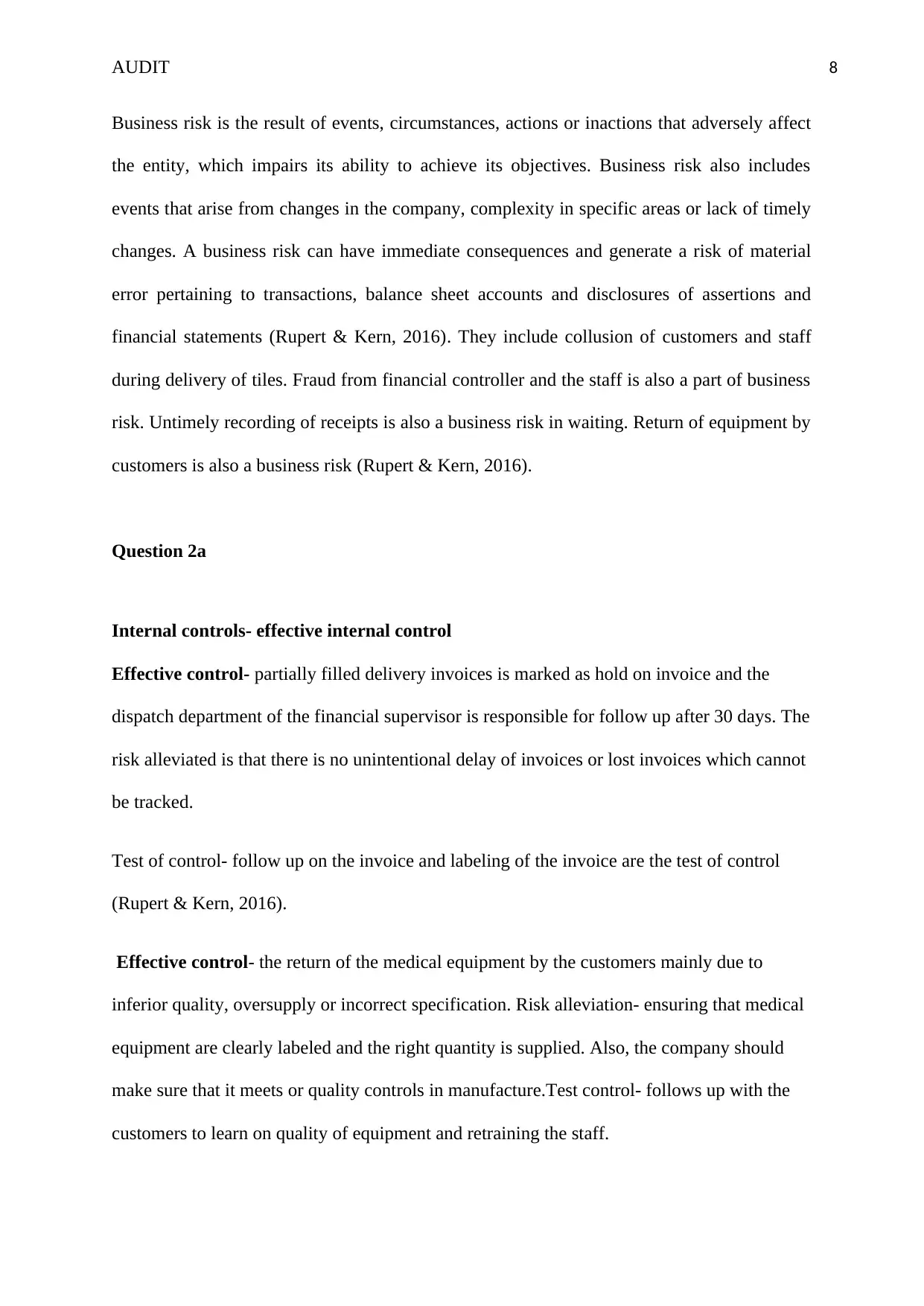
AUDIT 8
Business risk is the result of events, circumstances, actions or inactions that adversely affect
the entity, which impairs its ability to achieve its objectives. Business risk also includes
events that arise from changes in the company, complexity in specific areas or lack of timely
changes. A business risk can have immediate consequences and generate a risk of material
error pertaining to transactions, balance sheet accounts and disclosures of assertions and
financial statements (Rupert & Kern, 2016). They include collusion of customers and staff
during delivery of tiles. Fraud from financial controller and the staff is also a part of business
risk. Untimely recording of receipts is also a business risk in waiting. Return of equipment by
customers is also a business risk (Rupert & Kern, 2016).
Question 2a
Internal controls- effective internal control
Effective control- partially filled delivery invoices is marked as hold on invoice and the
dispatch department of the financial supervisor is responsible for follow up after 30 days. The
risk alleviated is that there is no unintentional delay of invoices or lost invoices which cannot
be tracked.
Test of control- follow up on the invoice and labeling of the invoice are the test of control
(Rupert & Kern, 2016).
Effective control- the return of the medical equipment by the customers mainly due to
inferior quality, oversupply or incorrect specification. Risk alleviation- ensuring that medical
equipment are clearly labeled and the right quantity is supplied. Also, the company should
make sure that it meets or quality controls in manufacture.Test control- follows up with the
customers to learn on quality of equipment and retraining the staff.
Business risk is the result of events, circumstances, actions or inactions that adversely affect
the entity, which impairs its ability to achieve its objectives. Business risk also includes
events that arise from changes in the company, complexity in specific areas or lack of timely
changes. A business risk can have immediate consequences and generate a risk of material
error pertaining to transactions, balance sheet accounts and disclosures of assertions and
financial statements (Rupert & Kern, 2016). They include collusion of customers and staff
during delivery of tiles. Fraud from financial controller and the staff is also a part of business
risk. Untimely recording of receipts is also a business risk in waiting. Return of equipment by
customers is also a business risk (Rupert & Kern, 2016).
Question 2a
Internal controls- effective internal control
Effective control- partially filled delivery invoices is marked as hold on invoice and the
dispatch department of the financial supervisor is responsible for follow up after 30 days. The
risk alleviated is that there is no unintentional delay of invoices or lost invoices which cannot
be tracked.
Test of control- follow up on the invoice and labeling of the invoice are the test of control
(Rupert & Kern, 2016).
Effective control- the return of the medical equipment by the customers mainly due to
inferior quality, oversupply or incorrect specification. Risk alleviation- ensuring that medical
equipment are clearly labeled and the right quantity is supplied. Also, the company should
make sure that it meets or quality controls in manufacture.Test control- follows up with the
customers to learn on quality of equipment and retraining the staff.
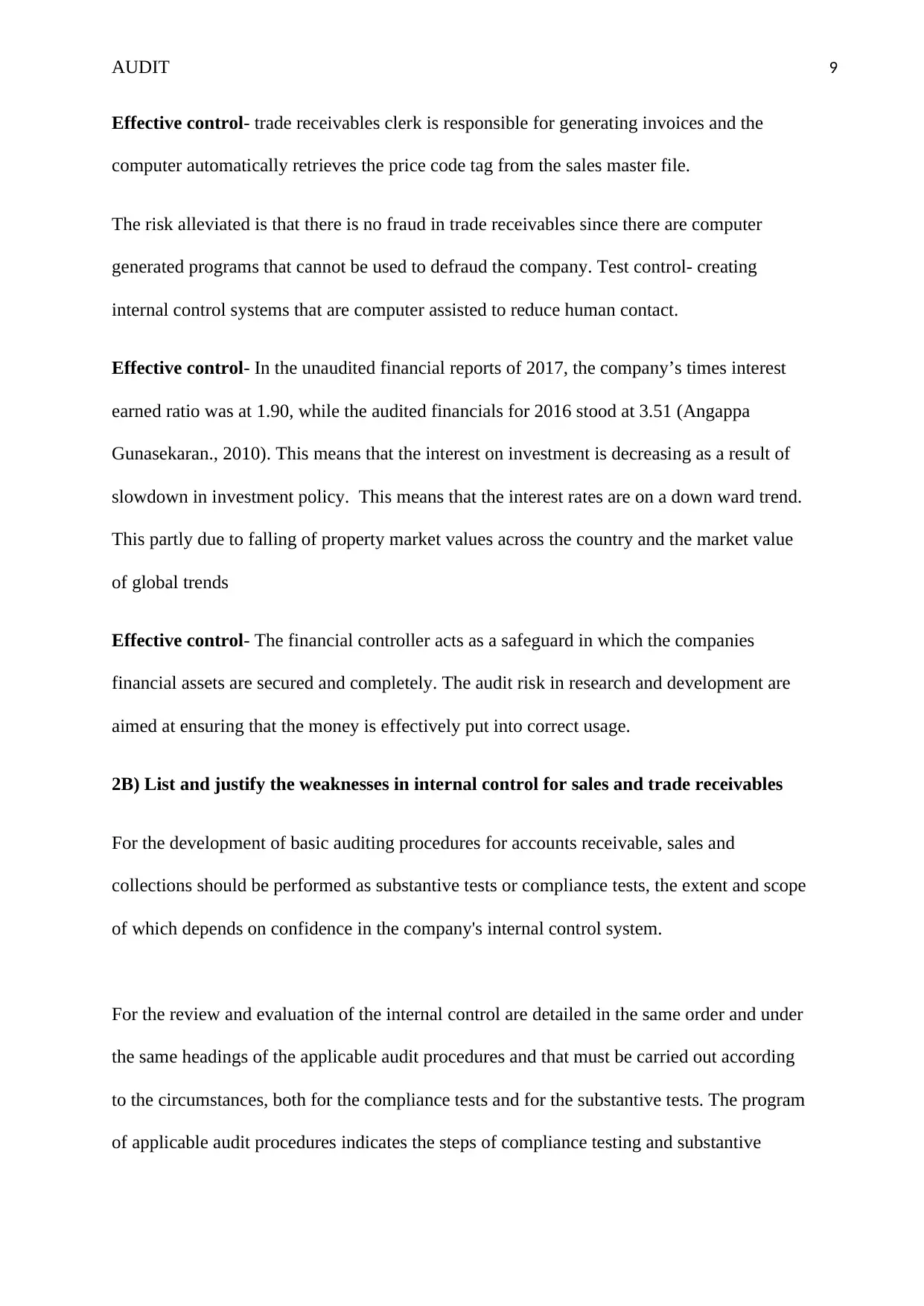
AUDIT 9
Effective control- trade receivables clerk is responsible for generating invoices and the
computer automatically retrieves the price code tag from the sales master file.
The risk alleviated is that there is no fraud in trade receivables since there are computer
generated programs that cannot be used to defraud the company. Test control- creating
internal control systems that are computer assisted to reduce human contact.
Effective control- In the unaudited financial reports of 2017, the company’s times interest
earned ratio was at 1.90, while the audited financials for 2016 stood at 3.51 (Angappa
Gunasekaran., 2010). This means that the interest on investment is decreasing as a result of
slowdown in investment policy. This means that the interest rates are on a down ward trend.
This partly due to falling of property market values across the country and the market value
of global trends
Effective control- The financial controller acts as a safeguard in which the companies
financial assets are secured and completely. The audit risk in research and development are
aimed at ensuring that the money is effectively put into correct usage.
2B) List and justify the weaknesses in internal control for sales and trade receivables
For the development of basic auditing procedures for accounts receivable, sales and
collections should be performed as substantive tests or compliance tests, the extent and scope
of which depends on confidence in the company's internal control system.
For the review and evaluation of the internal control are detailed in the same order and under
the same headings of the applicable audit procedures and that must be carried out according
to the circumstances, both for the compliance tests and for the substantive tests. The program
of applicable audit procedures indicates the steps of compliance testing and substantive
Effective control- trade receivables clerk is responsible for generating invoices and the
computer automatically retrieves the price code tag from the sales master file.
The risk alleviated is that there is no fraud in trade receivables since there are computer
generated programs that cannot be used to defraud the company. Test control- creating
internal control systems that are computer assisted to reduce human contact.
Effective control- In the unaudited financial reports of 2017, the company’s times interest
earned ratio was at 1.90, while the audited financials for 2016 stood at 3.51 (Angappa
Gunasekaran., 2010). This means that the interest on investment is decreasing as a result of
slowdown in investment policy. This means that the interest rates are on a down ward trend.
This partly due to falling of property market values across the country and the market value
of global trends
Effective control- The financial controller acts as a safeguard in which the companies
financial assets are secured and completely. The audit risk in research and development are
aimed at ensuring that the money is effectively put into correct usage.
2B) List and justify the weaknesses in internal control for sales and trade receivables
For the development of basic auditing procedures for accounts receivable, sales and
collections should be performed as substantive tests or compliance tests, the extent and scope
of which depends on confidence in the company's internal control system.
For the review and evaluation of the internal control are detailed in the same order and under
the same headings of the applicable audit procedures and that must be carried out according
to the circumstances, both for the compliance tests and for the substantive tests. The program
of applicable audit procedures indicates the steps of compliance testing and substantive
⊘ This is a preview!⊘
Do you want full access?
Subscribe today to unlock all pages.

Trusted by 1+ million students worldwide
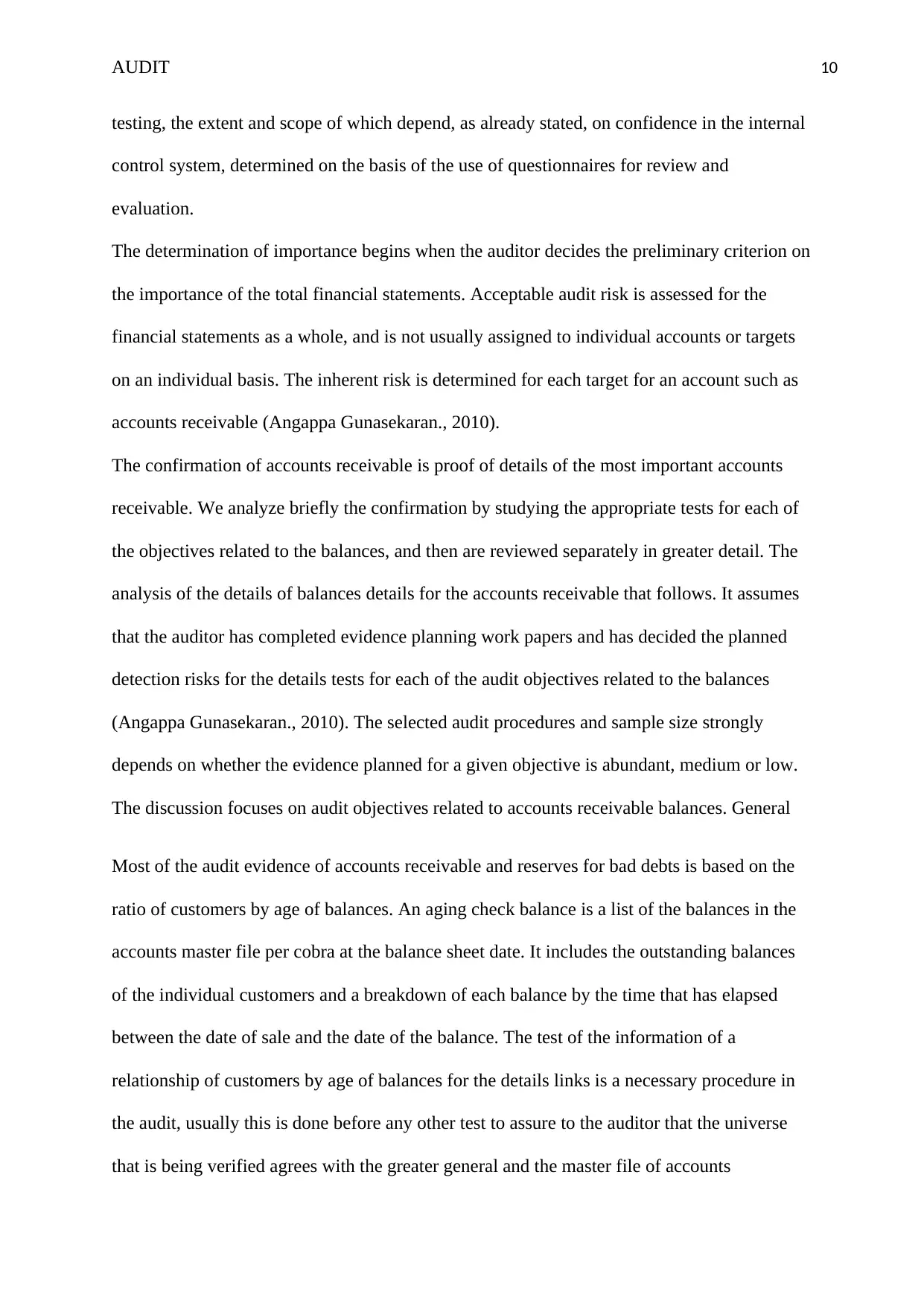
AUDIT 10
testing, the extent and scope of which depend, as already stated, on confidence in the internal
control system, determined on the basis of the use of questionnaires for review and
evaluation.
The determination of importance begins when the auditor decides the preliminary criterion on
the importance of the total financial statements. Acceptable audit risk is assessed for the
financial statements as a whole, and is not usually assigned to individual accounts or targets
on an individual basis. The inherent risk is determined for each target for an account such as
accounts receivable (Angappa Gunasekaran., 2010).
The confirmation of accounts receivable is proof of details of the most important accounts
receivable. We analyze briefly the confirmation by studying the appropriate tests for each of
the objectives related to the balances, and then are reviewed separately in greater detail. The
analysis of the details of balances details for the accounts receivable that follows. It assumes
that the auditor has completed evidence planning work papers and has decided the planned
detection risks for the details tests for each of the audit objectives related to the balances
(Angappa Gunasekaran., 2010). The selected audit procedures and sample size strongly
depends on whether the evidence planned for a given objective is abundant, medium or low.
The discussion focuses on audit objectives related to accounts receivable balances. General
Most of the audit evidence of accounts receivable and reserves for bad debts is based on the
ratio of customers by age of balances. An aging check balance is a list of the balances in the
accounts master file per cobra at the balance sheet date. It includes the outstanding balances
of the individual customers and a breakdown of each balance by the time that has elapsed
between the date of sale and the date of the balance. The test of the information of a
relationship of customers by age of balances for the details links is a necessary procedure in
the audit, usually this is done before any other test to assure to the auditor that the universe
that is being verified agrees with the greater general and the master file of accounts
testing, the extent and scope of which depend, as already stated, on confidence in the internal
control system, determined on the basis of the use of questionnaires for review and
evaluation.
The determination of importance begins when the auditor decides the preliminary criterion on
the importance of the total financial statements. Acceptable audit risk is assessed for the
financial statements as a whole, and is not usually assigned to individual accounts or targets
on an individual basis. The inherent risk is determined for each target for an account such as
accounts receivable (Angappa Gunasekaran., 2010).
The confirmation of accounts receivable is proof of details of the most important accounts
receivable. We analyze briefly the confirmation by studying the appropriate tests for each of
the objectives related to the balances, and then are reviewed separately in greater detail. The
analysis of the details of balances details for the accounts receivable that follows. It assumes
that the auditor has completed evidence planning work papers and has decided the planned
detection risks for the details tests for each of the audit objectives related to the balances
(Angappa Gunasekaran., 2010). The selected audit procedures and sample size strongly
depends on whether the evidence planned for a given objective is abundant, medium or low.
The discussion focuses on audit objectives related to accounts receivable balances. General
Most of the audit evidence of accounts receivable and reserves for bad debts is based on the
ratio of customers by age of balances. An aging check balance is a list of the balances in the
accounts master file per cobra at the balance sheet date. It includes the outstanding balances
of the individual customers and a breakdown of each balance by the time that has elapsed
between the date of sale and the date of the balance. The test of the information of a
relationship of customers by age of balances for the details links is a necessary procedure in
the audit, usually this is done before any other test to assure to the auditor that the universe
that is being verified agrees with the greater general and the master file of accounts
Paraphrase This Document
Need a fresh take? Get an instant paraphrase of this document with our AI Paraphraser
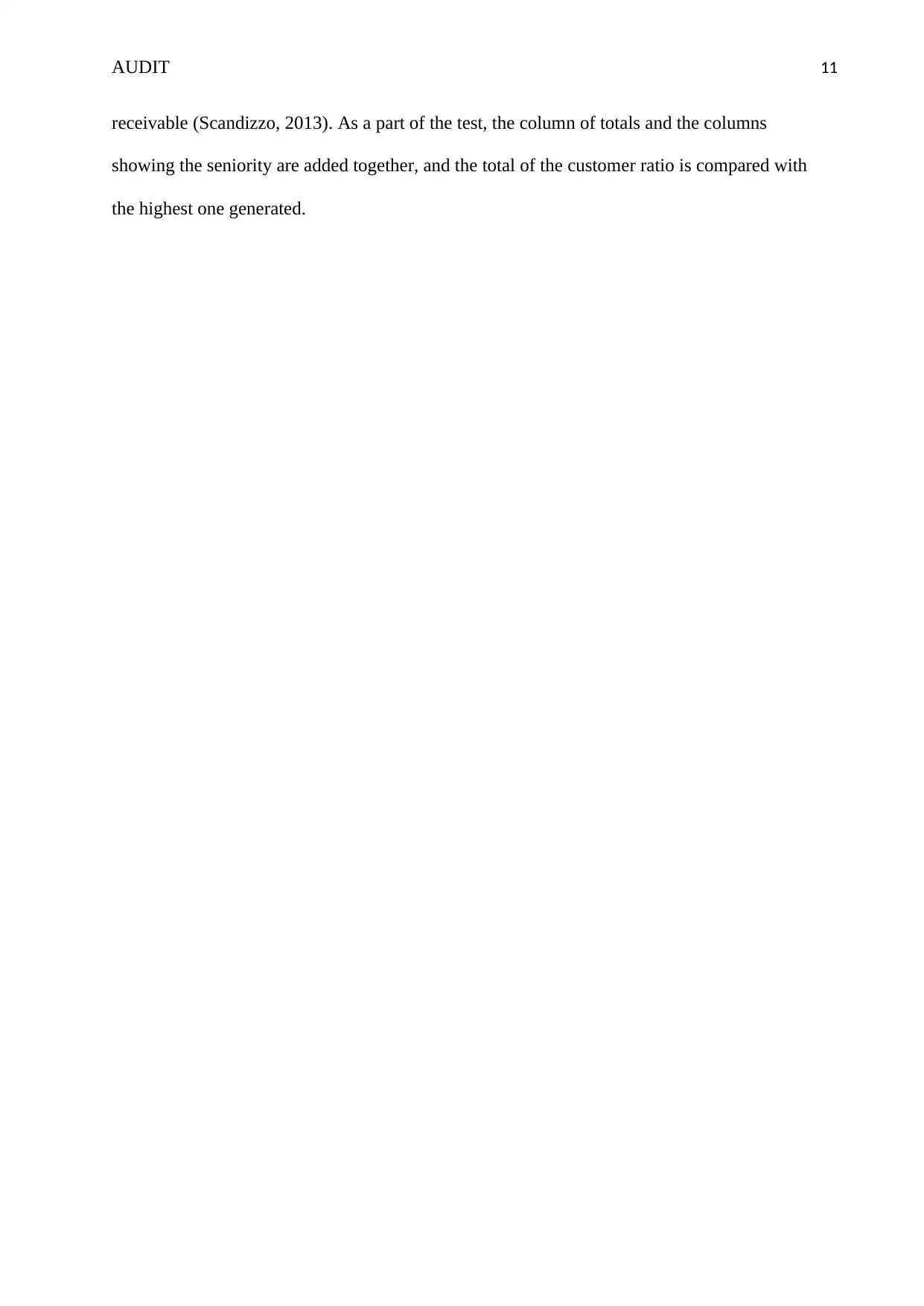
AUDIT 11
receivable (Scandizzo, 2013). As a part of the test, the column of totals and the columns
showing the seniority are added together, and the total of the customer ratio is compared with
the highest one generated.
receivable (Scandizzo, 2013). As a part of the test, the column of totals and the columns
showing the seniority are added together, and the total of the customer ratio is compared with
the highest one generated.
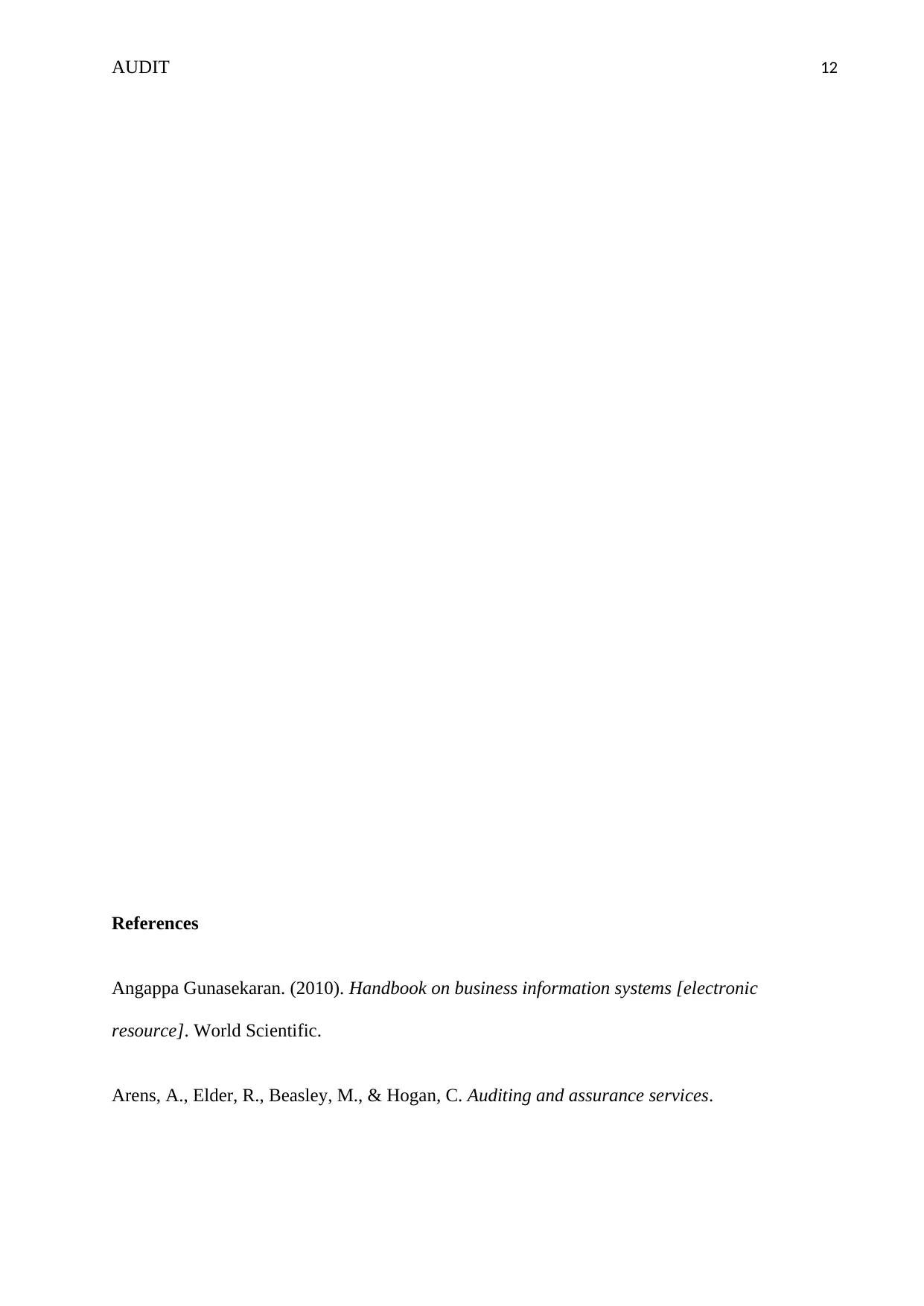
AUDIT 12
References
Angappa Gunasekaran. (2010). Handbook on business information systems [electronic
resource]. World Scientific.
Arens, A., Elder, R., Beasley, M., & Hogan, C. Auditing and assurance services.
References
Angappa Gunasekaran. (2010). Handbook on business information systems [electronic
resource]. World Scientific.
Arens, A., Elder, R., Beasley, M., & Hogan, C. Auditing and assurance services.
⊘ This is a preview!⊘
Do you want full access?
Subscribe today to unlock all pages.

Trusted by 1+ million students worldwide
1 out of 13
Related Documents
Your All-in-One AI-Powered Toolkit for Academic Success.
+13062052269
info@desklib.com
Available 24*7 on WhatsApp / Email
![[object Object]](/_next/static/media/star-bottom.7253800d.svg)
Unlock your academic potential
Copyright © 2020–2025 A2Z Services. All Rights Reserved. Developed and managed by ZUCOL.





